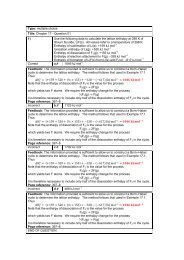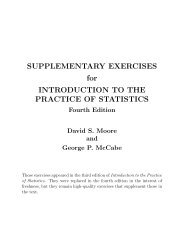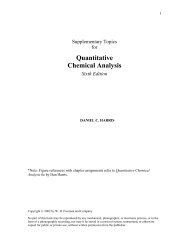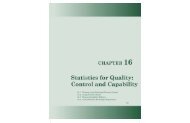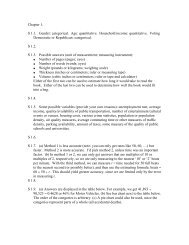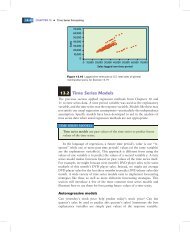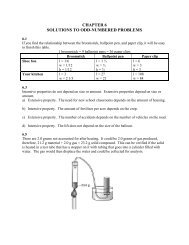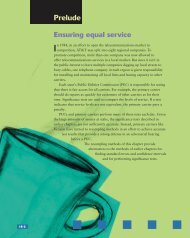- Page 1 and 2: Math for LifeLifeSEVENTH EDITIONThe
- Page 3 and 4: Math for LifeTOPIC 1: UNITS AND CON
- Page 5: Math for LifeTOPIC 1: UNITS AND CON
- Page 9 and 10: Math for LifeTOPIC 1: UNITS AND CON
- Page 11 and 12: Math for LifeTOPIC 1: UNITS AND CON
- Page 13 and 14: Math for LifeTOPIC 1: UNITS AND CON
- Page 15 and 16: Math for LifeTOPIC 1: UNITS AND CON
- Page 17 and 18: Math for LifeTOPIC 1: UNITS AND CON
- Page 19 and 20: Math for LifeTOPIC 1: UNITS AND CON
- Page 21 and 22: Math for LifeTOPIC 1: UNITS AND CON
- Page 23 and 24: Math for LifeLifeSEVENTH EDITIONThe
- Page 25 and 26: Math for LifeTOPIC 2: EXPONENTS AND
- Page 27 and 28: Math for LifeTOPIC 2: EXPONENTS AND
- Page 29 and 30: Math for LifeTOPIC 2: EXPONENTS AND
- Page 31 and 32: Math for LifeTOPIC 2: EXPONENTS AND
- Page 33 and 34: Math for LifeTOPIC 2: EXPONENTS AND
- Page 35 and 36: Math for LifeTOPIC 3: NUMERICAL DAT
- Page 37 and 38: Math for LifeTOPIC 3: NUMERICAL DAT
- Page 39 and 40: Math for LifeTOPIC 3: NUMERICAL DAT
- Page 41 and 42: Math for LifeTOPIC 3: NUMERICAL DAT
- Page 43 and 44: Math for LifeTOPIC 3: NUMERICAL DAT
- Page 45 and 46: Math for LifeTOPIC 3: NUMERICAL DAT
- Page 47 and 48: Math for LifeTOPIC 3: NUMERICAL DAT
- Page 49 and 50: Math for LifeLifeSEVENTH EDITIONThe
- Page 51 and 52: Math for LifeTOPIC 4: MAKING SOLUTI
- Page 53 and 54: Math for LifeTOPIC 4: MAKING SOLUTI
- Page 55 and 56: Math for LifeTOPIC 4: MAKING SOLUTI
- Page 57 and 58:
Math for LifeTOPIC 4: MAKING SOLUTI
- Page 59 and 60:
Math for LifeTOPIC 4: MAKING SOLUTI
- Page 61 and 62:
Math for LifeTOPIC 4: MAKING SOLUTI
- Page 63 and 64:
Math for LifeTOPIC 4: MAKING SOLUTI
- Page 65 and 66:
Math for LifeTOPIC 4: MAKING SOLUTI
- Page 67 and 68:
Math for LifeTOPIC 4: MAKING SOLUTI
- Page 69 and 70:
Math for LifeTOPIC 4: MAKING SOLUTI
- Page 71 and 72:
Math for LifeTOPIC 4: MAKING SOLUTI
- Page 73 and 74:
Math for LifeTOPIC 4: MAKING SOLUTI
- Page 75 and 76:
Math for LifeTOPIC 4: MAKING SOLUTI
- Page 77 and 78:
Math for LifeLifeSEVENTH EDITIONThe
- Page 79 and 80:
Math for LifeTOPIC 5: pH AND BUFFER
- Page 81 and 82:
Math for LifeTOPIC 5: pH AND BUFFER
- Page 83 and 84:
Math for LifeTOPIC 5: pH AND BUFFER
- Page 85 and 86:
Math for LifeTOPIC 5: pH AND BUFFER
- Page 87 and 88:
Math for LifeTOPIC 5: pH AND BUFFER
- Page 89 and 90:
Math for LifeTOPIC 6: RATES, REACTI
- Page 91 and 92:
Math for LifeTOPIC 6: RATES, REACTI
- Page 93 and 94:
Math for LifeTOPIC 6: RATES, REACTI
- Page 95 and 96:
Math for LifeTOPIC 6: RATES, REACTI
- Page 97 and 98:
Math for LifeTOPIC 6: RATES, REACTI
- Page 99 and 100:
Math for LifeTOPIC 6: RATES, REACTI
- Page 101 and 102:
Math for LifeTOPIC 6: RATES, REACTI
- Page 103 and 104:
Math for LifeLifeSEVENTH EDITIONThe
- Page 105 and 106:
Math for LifeTOPIC 7: MAPPING GENES
- Page 107 and 108:
Math for LifeTOPIC 7: MAPPING GENES
- Page 109 and 110:
Math for LifeTOPIC 7: MAPPING GENES
- Page 111 and 112:
Math for LifeTOPIC 7: MAPPING GENES
- Page 113 and 114:
Math for LifeLifeSEVENTH EDITIONThe
- Page 115 and 116:
Math for LifeTOPIC 8: PUNNETT SQUAR
- Page 117 and 118:
Math for LifeTOPIC 8: PUNNETT SQUAR
- Page 119 and 120:
Math for LifeTOPIC 8: PUNNETT SQUAR
- Page 121 and 122:
Math for LifeTOPIC 8: PUNNETT SQUAR
- Page 123 and 124:
Math for LifeTOPIC 8: PUNNETT SQUAR
- Page 125 and 126:
Math for LifeLifeSEVENTH EDITIONThe
- Page 127 and 128:
Math for LifeTOPIC 9: RADIOACTIVE D
- Page 129 and 130:
Math for LifeTOPIC 9: RADIOACTIVE D
- Page 131 and 132:
Math for LifeTOPIC 9: RADIOACTIVE D
- Page 133 and 134:
Math for LifeTOPIC 9: RADIOACTIVE D
- Page 135 and 136:
Math for LifeREFERENCE TABLESNUMERI
- Page 137 and 138:
Math for LifeREFERENCE TABLESOther
- Page 139 and 140:
Math for LifeUSEFUL FORMULASGeometr
- Page 141 and 142:
Math for LifeREFERENCE TABLESImport
- Page 143 and 144:
Math for LifeREFERENCE TABLESTHE EL
- Page 145 and 146:
Math for LifeREFERENCE TABLESNotice
- Page 147 and 148:
Math for LifeREFERENCE TABLESImprov
- Page 149 and 150:
Math for LifeREFERENCE TABLES∆E =
- Page 151 and 152:
Math for LifeREFERENCE TABLESA BIOL
- Page 153 and 154:
Math for LifeREFERENCE TABLESBIOLOG
- Page 155 and 156:
Math for LifeREFERENCE TABLESBUFFER
- Page 157 and 158:
Math for LifeREFERENCE TABLESText F
- Page 159 and 160:
Math for LifeAlphabetical by single
- Page 161 and 162:
Math for LifeREFERENCE TABLESLIPIDS
- Page 163 and 164:
Math for LifeREFERENCE TABLESLIPIDS
- Page 165 and 166:
Math for LifeREFERENCE TABLESThree-
- Page 167 and 168:
Math for LifeREFERENCE TABLESCARBOH
- Page 169 and 170:
Math for LifeREFERENCE TABLESPROTEI
- Page 171 and 172:
Math for LifeREFERENCE TABLESNUCLEI
- Page 173 and 174:
Math for LifeREFERENCE TABLESNUCLEI
- Page 175 and 176:
Math for LifeREFERENCE TABLESH = hy
- Page 177 and 178:
Math for LifeREFERENCE TABLESH + =
- Page 179 and 180:
Math for LifeREFERENCE TABLES∆G =
- Page 181 and 182:
Math for LifeREFERENCE TABLESEVOLUT





